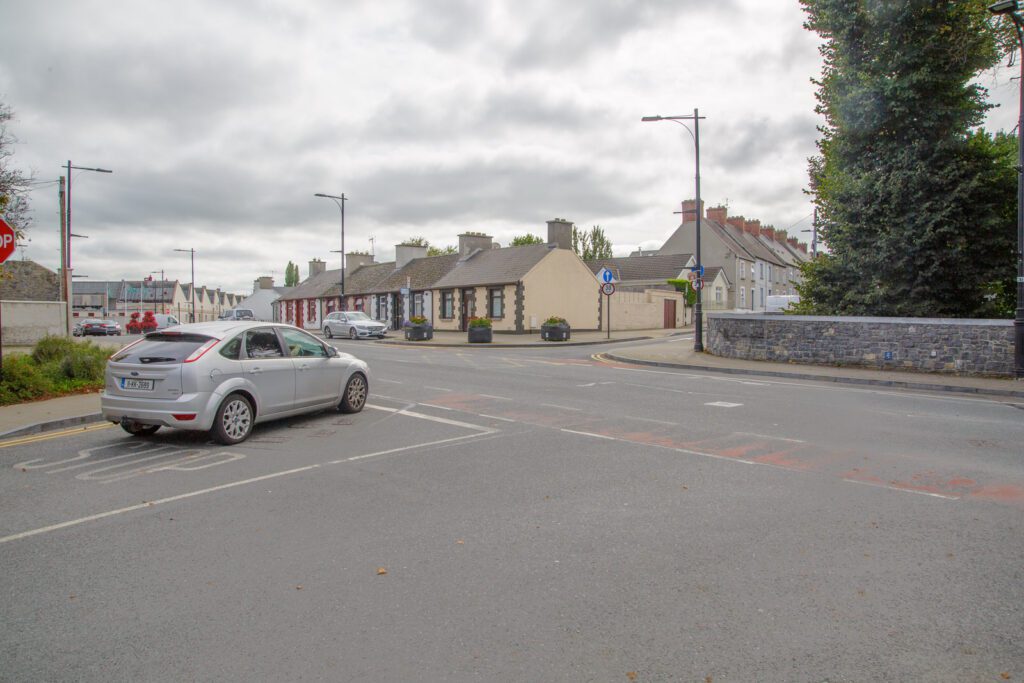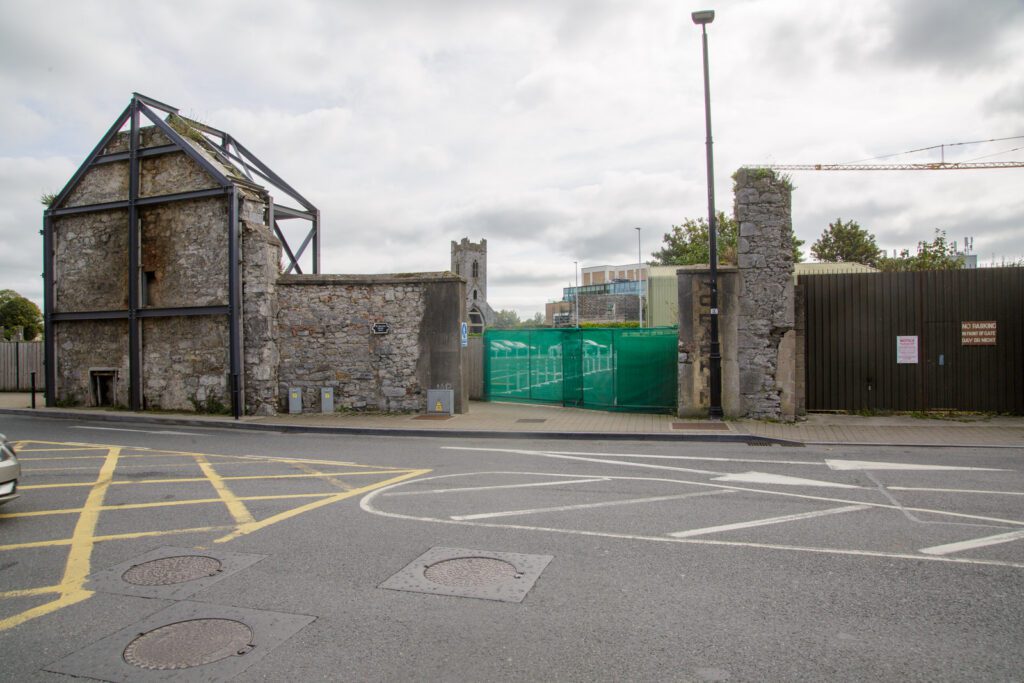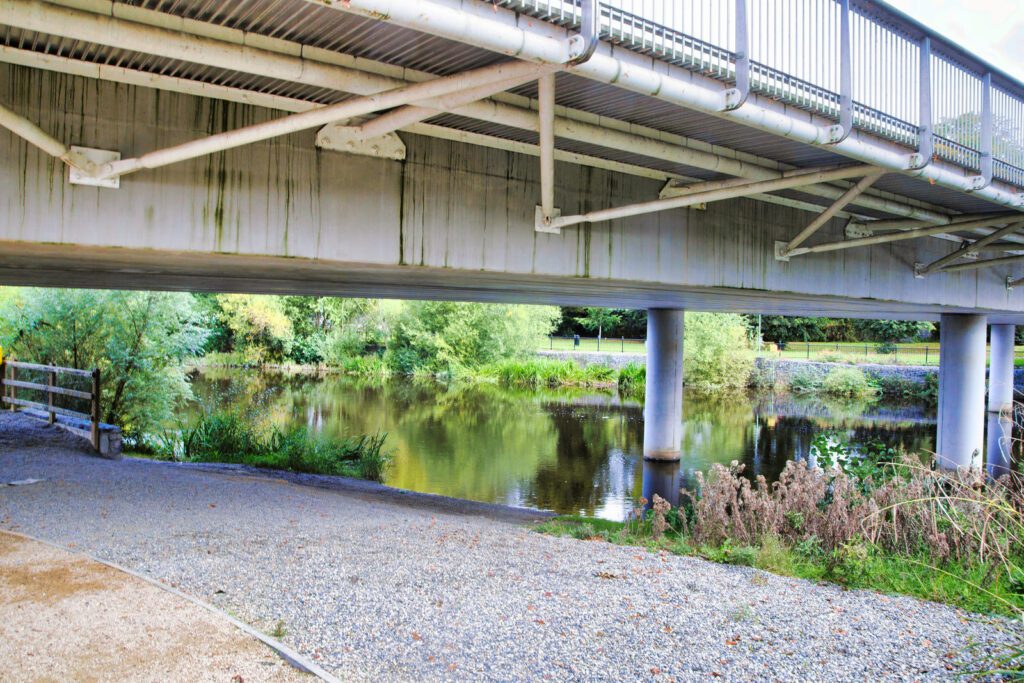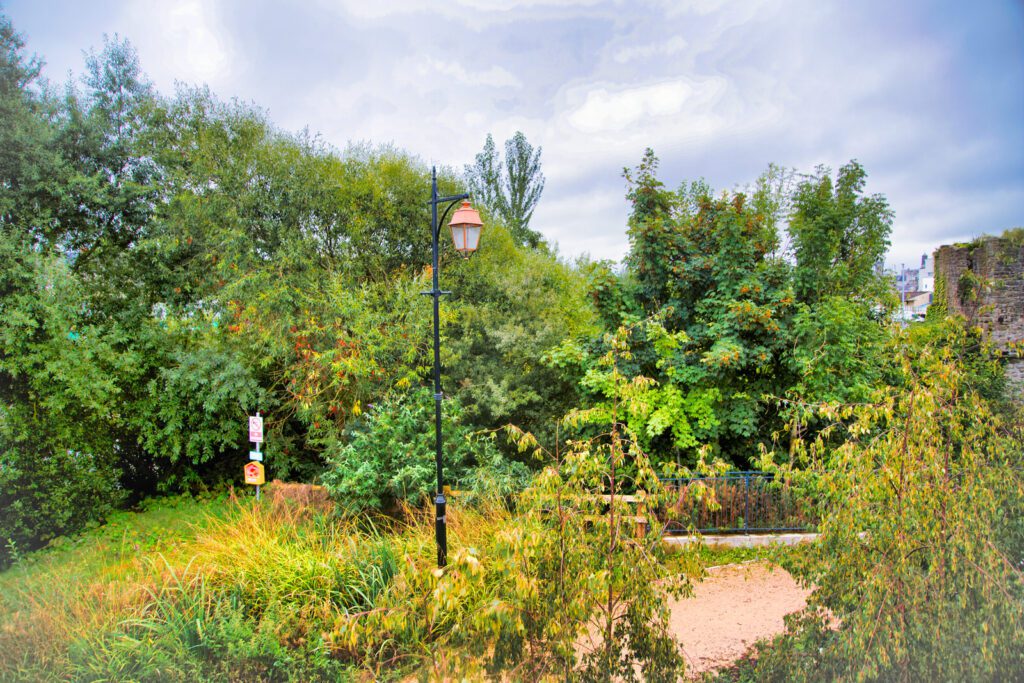2017 LEGACY PHOTO COLLECTION BY WILLIAM MURPHY
Lady Desart and Her Enduring Legacy in Kilkenny
Ellen Odette Cuffe, Lady Desart, was more than just a woman of considerable wealth; she was a driving force in Kilkenny’s history, leaving an enduring legacy of philanthropy and social reform. Born in London in 1857 to a prominent Jewish banking family, she married William Cuffe, the 4th Earl of Desart, in 1881. While not a native of Ireland, she became an integral part of the Kilkenny community, devoting her life to improving the lives of its citizens, especially after her husband’s death in 1898.
Lady Desart’s Importance in Kilkenny and Beyond
Lady Desart’s influence transcended her philanthropic activities. She was a woman of significant social standing, admired for her dedication to public service and her passion for Irish culture. She served as President of the Gaelic League’s Women’s Committee from 1908 to 1933, playing a pivotal role in the rescue of an estimated 300,000 women and children. Remarkably, she was also one of the first women to serve in the Irish Senate, appointed in 1922, where she remained for 12 years until her passing. It is a curious fact that despite her own political achievements, she initially opposed women’s suffrage, believing women should not compete with men in work or public life. This contradiction perhaps reflects the complexities of her time and her evolving views on women’s roles in society.
Her dedication to the Irish language was particularly striking. She drew a compelling parallel between the Jewish revival of Hebrew and the Gaelic League’s endeavors, actively championing the revitalization of the Irish language. This connection between her Jewish heritage and her support for Irish cultural identity underscores her deep appreciation for cultural preservation and national pride. In recognition of her tireless work in Kilkenny, she was granted the Freedom of the City in 1910, a rare and prestigious honour for a woman in that era.
Lady Desart’s contributions to Kilkenny were extensive and diverse. She established vital institutions, supported local industries, and championed social causes. The following table provides a glimpse into the breadth of her endeavors:
Kilkenny Library: Donated the land, purchased for £600, and funded the furnishing of the Carnegie Library, which she officially opened on November 3rd, 1910 with a silver key supplied by P.T. Murphy, Jeweller.
Aut Even Hospital: Established Aut Even Hospital, providing essential medical care to the community.
The Woollen Mills: Restored and rebuilt a derelict woollen mill at Talbot’s Inch, creating employment opportunities.
Kilkenny Woodworkers: Supported the Kilkenny Woodworkers, a group of skilled craftsmen inspired by the Arts and Crafts movement, who contributed to the city’s architectural heritage.
Tobacco Growers Association: Backed the Tobacco Growers Association, demonstrating her commitment to diverse economic initiatives.
Talbots Inch Village: Developed a model village for mill workers, providing housing, a school, a recreation hall, and a dental surgery.
Irish Dairy Shorthorn Breeders’ Association: Served as president of this association and presented the Desart cup for annual competitions.
Rescuing Jewish Children: Played a role in rescuing Jewish children from Nazi Germany in the 1930s.
Beyond these notable contributions, Lady Desart left a lasting impact through her generous philanthropy. Upon her death, her will revealed a bequest of £1,500,000, all of which was donated to various charities she supported throughout her life.
The Fate of Lady Desart and Her Family
Lady Desart’s marriage to William Cuffe did not result in any children. When William died prematurely in 1898 at the age of 53, she initially sought solace with her family in Ascot, Berkshire. However, the death of her brother-in-law, Otway Cuffe, drew her back to Kilkenny, where she continued his work in the community.
The Desart family line continued through William’s brother, Hamilton Cuffe, the 5th Earl of Desart. Hamilton and his wife, Lady Margaret Joan Lascelles, had two daughters, Lady Joan Elizabeth Cuffe and Lady Sybil Marjorie Cuffe. Tragedy struck the family when Desart Court was burned down. Hamilton, overwhelmed by the loss and lacking the resources to rebuild, handed the estate over to his niece, Lady Kathleen Pilkington. With the help of architect Richard Orpen and the building company McLaughlin & Harvey, Lady Kathleen restored the property, reopening it in 1926.
Lady Desart’s Burial Place
Lady Desart passed away in Dublin on June 29, 1933, at the age of 75. She was laid to rest beside her husband in Falmouth Cemetery, Cornwall, England. Their shared tombstone is inscribed with a poignant testament to their enduring bond: “They were together in their lives, and in their deaths they shall not be divided.” Her grave can be found in Section E, Row B, Grave 2 of the cemetery.
The Lady Desart Pedestrian and Cycle Bridge
The Lady Desart Pedestrian and Cycle Bridge stands as a modern-day testament to Lady Desart’s enduring legacy in Kilkenny. This 130-foot long structure, gracefully spanning the River Nore from Bateman Quay to John’s Quay, was officially opened on January 30th, 2014. It is the first bridge to be built in the city in over 30 years. Constructed at a cost of €600,000, the bridge not only provides convenient access to the city’s main shopping area but also encourages residents and visitors to embrace walking and cycling as sustainable modes of transport. It is a fitting tribute to a woman who dedicated her life to improving Kilkenny, connecting the city’s past and present while promoting a sustainable future.
Reasons for the Bridge’s Installation
The construction of the Lady Desart Pedestrian and Cycle Bridge was motivated by a desire to enhance accessibility and connectivity within the city. It provides a safe and convenient route for pedestrians and cyclists, promoting a healthier and more environmentally friendly way to navigate Kilkenny. The bridge aligns with the Irish government’s “Smarter Travel” initiative, which aims to reduce traffic congestion and encourage sustainable transportation options. Furthermore, the project demonstrated a commitment to environmental responsibility, with careful consideration given to the sensitive ecosystem of the River Nore during its construction.
Interestingly, the opening ceremony of the bridge was not without incident. A group of protestors gathered, not to oppose the bridge itself, but to voice their concerns about the proposed Central Access Scheme, which involved the construction of a larger road bridge nearby.
Historical Flooding and the Earlier Bridge
The Lady Desart Pedestrian and Cycle Bridge replaced an earlier suspension bridge built by Lady Desart in 1912. This original bridge was constructed to ensure the safe passage of workers across the River Nore from their homes in Talbot’s Inch village to the Greenvale Woollen Mills on the opposite bank. Sadly, this bridge, a symbol of Lady Desart’s commitment to the well-being of her workers, was destroyed by the Great Flood of 1947. This devastating flood, a consequence of rapidly melting snow after weeks of heavy snowfall, wreaked havoc on Kilkenny. The collapse of the bridge was attributed not only to the force of the floodwaters, which carried a large uprooted tree downstream, but also to the lack of maintenance on the structure following Lady Desart’s death.
Flooding has been a recurring challenge for Kilkenny throughout its history. In 1926, the city experienced another calamitous flood, the worst in living memory at the time. Even further back, in 1763, a great flood swept away John’s Bridge and Greensbridge, causing widespread damage and disruption. These events highlight the vulnerability of the area to the forces of nature.
Today, remnants of Lady Desart’s original bridge can still be seen along the River Nore Linear Park. Maintenance work has exposed the concrete ramp leading up to the bridge, the steel column supports, and the suspension cables. To commemorate this piece of history, Canice Architects designed an interpretation panel featuring a brief history of the bridge, an etching of the old structure, and a mark indicating the water level reached during the 1947 flood.
For many years, the people of Kilkenny relied on the expertise of engineer Harry Shine to predict floods. Using a series of gauges upstream, he accurately forecasted flood events, giving residents valuable time to prepare and evacuate. In recent times, a new flood relief scheme has been implemented, offering a more permanent solution to this age-old problem.
Conclusion:
Lady Desart’s legacy in Kilkenny is both profound and multifaceted. She was a philanthropist, a social activist, a businesswoman, and a politician. Her contributions were not isolated acts of charity but rather interconnected expressions of her deep commitment to the well-being of the Kilkenny community. She established essential institutions, fostered economic growth, championed Irish culture, and advocated for social justice. The Lady Desart Pedestrian and Cycle Bridge, a modern structure built upon the foundations of her earlier endeavours, serves as a powerful symbol of her enduring impact. It connects the city’s past and present, reminding us that the actions of individuals can shape communities and leave a lasting legacy for generations to come. Her story continues to inspire, demonstrating the transformative power of vision, dedication, and a genuine desire to make a difference in the world.
![THE LADY DESART PEDESTRIAN AND CYCLE BRIDGE [ACROSS THE RIVER NORE IN THE CITY OF KILKENNY]-245456-1 THE LADY DESART PEDESTRIAN AND CYCLE BRIDGE [ACROSS THE RIVER NORE IN THE CITY OF KILKENNY]-245456-1](https://excellentstreetimages.com/KilkennySeptember2022WordPress/wp-content/uploads/2024/12/THE-LADY-DESART-PEDESTRIAN-AND-CYCLE-BRIDGE-ACROSS-THE-RIVER-NORE-IN-THE-CITY-OF-KILKENNY-245456-1-1422x1067.jpg)
![THE LADY DESART PEDESTRIAN AND CYCLE BRIDGE [ACROSS THE RIVER NORE IN THE CITY OF KILKENNY]-245457-1 THE LADY DESART PEDESTRIAN AND CYCLE BRIDGE [ACROSS THE RIVER NORE IN THE CITY OF KILKENNY]-245457-1](https://excellentstreetimages.com/KilkennySeptember2022WordPress/wp-content/uploads/2024/12/THE-LADY-DESART-PEDESTRIAN-AND-CYCLE-BRIDGE-ACROSS-THE-RIVER-NORE-IN-THE-CITY-OF-KILKENNY-245457-1-1422x1067.jpg)
![THE LADY DESART PEDESTRIAN AND CYCLE BRIDGE [ACROSS THE RIVER NORE IN THE CITY OF KILKENNY]-245454-1 THE LADY DESART PEDESTRIAN AND CYCLE BRIDGE [ACROSS THE RIVER NORE IN THE CITY OF KILKENNY]-245454-1](https://excellentstreetimages.com/KilkennySeptember2022WordPress/wp-content/uploads/2024/12/THE-LADY-DESART-PEDESTRIAN-AND-CYCLE-BRIDGE-ACROSS-THE-RIVER-NORE-IN-THE-CITY-OF-KILKENNY-245454-1-1422x1067.jpg)
![THE LADY DESART PEDESTRIAN AND CYCLE BRIDGE [ACROSS THE RIVER NORE IN THE CITY OF KILKENNY]-245455-1 THE LADY DESART PEDESTRIAN AND CYCLE BRIDGE [ACROSS THE RIVER NORE IN THE CITY OF KILKENNY]-245455-1](https://excellentstreetimages.com/KilkennySeptember2022WordPress/wp-content/uploads/2024/12/THE-LADY-DESART-PEDESTRIAN-AND-CYCLE-BRIDGE-ACROSS-THE-RIVER-NORE-IN-THE-CITY-OF-KILKENNY-245455-1-1422x1067.jpg)
![THE LADY DESART PEDESTRIAN AND CYCLE BRIDGE [ACROSS THE RIVER NORE IN THE CITY OF KILKENNY]-245452-1 THE LADY DESART PEDESTRIAN AND CYCLE BRIDGE [ACROSS THE RIVER NORE IN THE CITY OF KILKENNY]-245452-1](https://excellentstreetimages.com/KilkennySeptember2022WordPress/wp-content/uploads/2024/12/THE-LADY-DESART-PEDESTRIAN-AND-CYCLE-BRIDGE-ACROSS-THE-RIVER-NORE-IN-THE-CITY-OF-KILKENNY-245452-1-1422x1067.jpg)
![THE LADY DESART PEDESTRIAN AND CYCLE BRIDGE [ACROSS THE RIVER NORE IN THE CITY OF KILKENNY]-245453-1 THE LADY DESART PEDESTRIAN AND CYCLE BRIDGE [ACROSS THE RIVER NORE IN THE CITY OF KILKENNY]-245453-1](https://excellentstreetimages.com/KilkennySeptember2022WordPress/wp-content/uploads/2024/12/THE-LADY-DESART-PEDESTRIAN-AND-CYCLE-BRIDGE-ACROSS-THE-RIVER-NORE-IN-THE-CITY-OF-KILKENNY-245453-1-1422x1067.jpg)
![THE LADY DESART PEDESTRIAN AND CYCLE BRIDGE [ACROSS THE RIVER NORE IN THE CITY OF KILKENNY]-245450-1 THE LADY DESART PEDESTRIAN AND CYCLE BRIDGE [ACROSS THE RIVER NORE IN THE CITY OF KILKENNY]-245450-1](https://excellentstreetimages.com/KilkennySeptember2022WordPress/wp-content/uploads/2024/12/THE-LADY-DESART-PEDESTRIAN-AND-CYCLE-BRIDGE-ACROSS-THE-RIVER-NORE-IN-THE-CITY-OF-KILKENNY-245450-1-1422x1067.jpg)
![THE LADY DESART PEDESTRIAN AND CYCLE BRIDGE [ACROSS THE RIVER NORE IN THE CITY OF KILKENNY]-245451-1 THE LADY DESART PEDESTRIAN AND CYCLE BRIDGE [ACROSS THE RIVER NORE IN THE CITY OF KILKENNY]-245451-1](https://excellentstreetimages.com/KilkennySeptember2022WordPress/wp-content/uploads/2024/12/THE-LADY-DESART-PEDESTRIAN-AND-CYCLE-BRIDGE-ACROSS-THE-RIVER-NORE-IN-THE-CITY-OF-KILKENNY-245451-1-1422x1067.jpg)
![THIS IS GREEN'S BRIDGE OR GREENSBRIDGE [I ACCIDENTALLY IDENTIFIED IT AS JOHN'S BRIDGE BECAUSE OF A GHOST STORY]-234315-1 THIS IS GREEN'S BRIDGE OR GREENSBRIDGE [I ACCIDENTALLY IDENTIFIED IT AS JOHN'S BRIDGE BECAUSE OF A GHOST STORY]-234315-1](https://excellentstreetimages.com/KilkennySeptember2022WordPress/wp-content/uploads/2024/06/THIS-IS-GREENS-BRIDGE-OR-GREENSBRIDGE-I-ACCIDENTALLY-IDENTIFIED-IT-AS-JOHNS-BRIDGE-BECAUSE-OF-A-GHOST-STORY-234315-1.jpg)
![THIS IS GREEN'S BRIDGE OR GREENSBRIDGE [I ACCIDENTALLY IDENTIFIED IT AS JOHN'S BRIDGE BECAUSE OF A GHOST STORY]-234314-1 THIS IS GREEN'S BRIDGE OR GREENSBRIDGE [I ACCIDENTALLY IDENTIFIED IT AS JOHN'S BRIDGE BECAUSE OF A GHOST STORY]-234314-1](https://excellentstreetimages.com/KilkennySeptember2022WordPress/wp-content/uploads/2024/06/THIS-IS-GREENS-BRIDGE-OR-GREENSBRIDGE-I-ACCIDENTALLY-IDENTIFIED-IT-AS-JOHNS-BRIDGE-BECAUSE-OF-A-GHOST-STORY-234314-1.jpg)
![THIS IS GREEN'S BRIDGE OR GREENSBRIDGE [I ACCIDENTALLY IDENTIFIED IT AS JOHN'S BRIDGE BECAUSE OF A GHOST STORY]-234313-1 THIS IS GREEN'S BRIDGE OR GREENSBRIDGE [I ACCIDENTALLY IDENTIFIED IT AS JOHN'S BRIDGE BECAUSE OF A GHOST STORY]-234313-1](https://excellentstreetimages.com/KilkennySeptember2022WordPress/wp-content/uploads/2024/06/THIS-IS-GREENS-BRIDGE-OR-GREENSBRIDGE-I-ACCIDENTALLY-IDENTIFIED-IT-AS-JOHNS-BRIDGE-BECAUSE-OF-A-GHOST-STORY-234313-1.jpg)
![THIS IS GREEN'S BRIDGE OR GREENSBRIDGE [I ACCIDENTALLY IDENTIFIED IT AS JOHN'S BRIDGE BECAUSE OF A GHOST STORY]-234311-1 THIS IS GREEN'S BRIDGE OR GREENSBRIDGE [I ACCIDENTALLY IDENTIFIED IT AS JOHN'S BRIDGE BECAUSE OF A GHOST STORY]-234311-1](https://excellentstreetimages.com/KilkennySeptember2022WordPress/wp-content/uploads/2024/06/THIS-IS-GREENS-BRIDGE-OR-GREENSBRIDGE-I-ACCIDENTALLY-IDENTIFIED-IT-AS-JOHNS-BRIDGE-BECAUSE-OF-A-GHOST-STORY-234311-1.jpg)
![THIS IS GREEN'S BRIDGE OR GREENSBRIDGE [I ACCIDENTALLY IDENTIFIED IT AS JOHN'S BRIDGE BECAUSE OF A GHOST STORY]-234312-1 THIS IS GREEN'S BRIDGE OR GREENSBRIDGE [I ACCIDENTALLY IDENTIFIED IT AS JOHN'S BRIDGE BECAUSE OF A GHOST STORY]-234312-1](https://excellentstreetimages.com/KilkennySeptember2022WordPress/wp-content/uploads/2024/06/THIS-IS-GREENS-BRIDGE-OR-GREENSBRIDGE-I-ACCIDENTALLY-IDENTIFIED-IT-AS-JOHNS-BRIDGE-BECAUSE-OF-A-GHOST-STORY-234312-1.jpg)
![THIS IS GREEN'S BRIDGE OR GREENSBRIDGE [I ACCIDENTALLY IDENTIFIED IT AS JOHN'S BRIDGE BECAUSE OF A GHOST STORY]-234309-1 THIS IS GREEN'S BRIDGE OR GREENSBRIDGE [I ACCIDENTALLY IDENTIFIED IT AS JOHN'S BRIDGE BECAUSE OF A GHOST STORY]-234309-1](https://excellentstreetimages.com/KilkennySeptember2022WordPress/wp-content/uploads/2024/06/THIS-IS-GREENS-BRIDGE-OR-GREENSBRIDGE-I-ACCIDENTALLY-IDENTIFIED-IT-AS-JOHNS-BRIDGE-BECAUSE-OF-A-GHOST-STORY-234309-1.jpg)
![THIS IS GREEN'S BRIDGE OR GREENSBRIDGE [I ACCIDENTALLY IDENTIFIED IT AS JOHN'S BRIDGE BECAUSE OF A GHOST STORY]-234310-1 THIS IS GREEN'S BRIDGE OR GREENSBRIDGE [I ACCIDENTALLY IDENTIFIED IT AS JOHN'S BRIDGE BECAUSE OF A GHOST STORY]-234310-1](https://excellentstreetimages.com/KilkennySeptember2022WordPress/wp-content/uploads/2024/06/THIS-IS-GREENS-BRIDGE-OR-GREENSBRIDGE-I-ACCIDENTALLY-IDENTIFIED-IT-AS-JOHNS-BRIDGE-BECAUSE-OF-A-GHOST-STORY-234310-1.jpg)
![THIS IS GREEN'S BRIDGE OR GREENSBRIDGE [I ACCIDENTALLY IDENTIFIED IT AS JOHN'S BRIDGE BECAUSE OF A GHOST STORY]-234307-1 THIS IS GREEN'S BRIDGE OR GREENSBRIDGE [I ACCIDENTALLY IDENTIFIED IT AS JOHN'S BRIDGE BECAUSE OF A GHOST STORY]-234307-1](https://excellentstreetimages.com/KilkennySeptember2022WordPress/wp-content/uploads/2024/06/THIS-IS-GREENS-BRIDGE-OR-GREENSBRIDGE-I-ACCIDENTALLY-IDENTIFIED-IT-AS-JOHNS-BRIDGE-BECAUSE-OF-A-GHOST-STORY-234307-1.jpg)
![THIS IS GREEN'S BRIDGE OR GREENSBRIDGE [I ACCIDENTALLY IDENTIFIED IT AS JOHN'S BRIDGE BECAUSE OF A GHOST STORY]-234308-1 THIS IS GREEN'S BRIDGE OR GREENSBRIDGE [I ACCIDENTALLY IDENTIFIED IT AS JOHN'S BRIDGE BECAUSE OF A GHOST STORY]-234308-1](https://excellentstreetimages.com/KilkennySeptember2022WordPress/wp-content/uploads/2024/06/THIS-IS-GREENS-BRIDGE-OR-GREENSBRIDGE-I-ACCIDENTALLY-IDENTIFIED-IT-AS-JOHNS-BRIDGE-BECAUSE-OF-A-GHOST-STORY-234308-1.jpg)
![THE NEW ST FRANCIS BRIDGE IN KILKENNY AND THE SURROUNDING AREA [OPENED TO THE PUBLIC IN 2017]-227066-1 THE NEW ST FRANCIS BRIDGE IN KILKENNY AND THE SURROUNDING AREA [OPENED TO THE PUBLIC IN 2017]-227066-1](https://excellentstreetimages.com/KilkennySeptember2022WordPress/wp-content/uploads/2024/01/THE-NEW-ST-FRANCIS-BRIDGE-IN-KILKENNY-AND-THE-SURROUNDING-AREA-OPENED-TO-THE-PUBLIC-IN-2017-227066-1.jpg)
![THE NEW ST FRANCIS BRIDGE IN KILKENNY AND THE SURROUNDING AREA [OPENED TO THE PUBLIC IN 2017]-227030-1 THE NEW ST FRANCIS BRIDGE IN KILKENNY AND THE SURROUNDING AREA [OPENED TO THE PUBLIC IN 2017]-227030-1](https://excellentstreetimages.com/KilkennySeptember2022WordPress/wp-content/uploads/2024/01/THE-NEW-ST-FRANCIS-BRIDGE-IN-KILKENNY-AND-THE-SURROUNDING-AREA-OPENED-TO-THE-PUBLIC-IN-2017-227030-1.jpg)
![THE NEW ST FRANCIS BRIDGE IN KILKENNY AND THE SURROUNDING AREA [OPENED TO THE PUBLIC IN 2017]-227029-1 THE NEW ST FRANCIS BRIDGE IN KILKENNY AND THE SURROUNDING AREA [OPENED TO THE PUBLIC IN 2017]-227029-1](https://excellentstreetimages.com/KilkennySeptember2022WordPress/wp-content/uploads/2024/01/THE-NEW-ST-FRANCIS-BRIDGE-IN-KILKENNY-AND-THE-SURROUNDING-AREA-OPENED-TO-THE-PUBLIC-IN-2017-227029-1.jpg)
![THE NEW ST FRANCIS BRIDGE IN KILKENNY AND THE SURROUNDING AREA [OPENED TO THE PUBLIC IN 2017]-227032-1 THE NEW ST FRANCIS BRIDGE IN KILKENNY AND THE SURROUNDING AREA [OPENED TO THE PUBLIC IN 2017]-227032-1](https://excellentstreetimages.com/KilkennySeptember2022WordPress/wp-content/uploads/2024/01/THE-NEW-ST-FRANCIS-BRIDGE-IN-KILKENNY-AND-THE-SURROUNDING-AREA-OPENED-TO-THE-PUBLIC-IN-2017-227032-1.jpg)
![THE NEW ST FRANCIS BRIDGE IN KILKENNY AND THE SURROUNDING AREA [OPENED TO THE PUBLIC IN 2017]-227031-1 THE NEW ST FRANCIS BRIDGE IN KILKENNY AND THE SURROUNDING AREA [OPENED TO THE PUBLIC IN 2017]-227031-1](https://excellentstreetimages.com/KilkennySeptember2022WordPress/wp-content/uploads/2024/01/THE-NEW-ST-FRANCIS-BRIDGE-IN-KILKENNY-AND-THE-SURROUNDING-AREA-OPENED-TO-THE-PUBLIC-IN-2017-227031-1.jpg)
![THE NEW ST FRANCIS BRIDGE IN KILKENNY AND THE SURROUNDING AREA [OPENED TO THE PUBLIC IN 2017]-227034-1 THE NEW ST FRANCIS BRIDGE IN KILKENNY AND THE SURROUNDING AREA [OPENED TO THE PUBLIC IN 2017]-227034-1](https://excellentstreetimages.com/KilkennySeptember2022WordPress/wp-content/uploads/2024/01/THE-NEW-ST-FRANCIS-BRIDGE-IN-KILKENNY-AND-THE-SURROUNDING-AREA-OPENED-TO-THE-PUBLIC-IN-2017-227034-1.jpg)
![THE NEW ST FRANCIS BRIDGE IN KILKENNY AND THE SURROUNDING AREA [OPENED TO THE PUBLIC IN 2017]-227033-1 THE NEW ST FRANCIS BRIDGE IN KILKENNY AND THE SURROUNDING AREA [OPENED TO THE PUBLIC IN 2017]-227033-1](https://excellentstreetimages.com/KilkennySeptember2022WordPress/wp-content/uploads/2024/01/THE-NEW-ST-FRANCIS-BRIDGE-IN-KILKENNY-AND-THE-SURROUNDING-AREA-OPENED-TO-THE-PUBLIC-IN-2017-227033-1-1292x861.jpg)
![THE NEW ST FRANCIS BRIDGE IN KILKENNY AND THE SURROUNDING AREA [OPENED TO THE PUBLIC IN 2017]-227037-1 THE NEW ST FRANCIS BRIDGE IN KILKENNY AND THE SURROUNDING AREA [OPENED TO THE PUBLIC IN 2017]-227037-1](https://excellentstreetimages.com/KilkennySeptember2022WordPress/wp-content/uploads/2024/01/THE-NEW-ST-FRANCIS-BRIDGE-IN-KILKENNY-AND-THE-SURROUNDING-AREA-OPENED-TO-THE-PUBLIC-IN-2017-227037-1.jpg)
![THE NEW ST FRANCIS BRIDGE IN KILKENNY AND THE SURROUNDING AREA [OPENED TO THE PUBLIC IN 2017]-227036-1 THE NEW ST FRANCIS BRIDGE IN KILKENNY AND THE SURROUNDING AREA [OPENED TO THE PUBLIC IN 2017]-227036-1](https://excellentstreetimages.com/KilkennySeptember2022WordPress/wp-content/uploads/2024/01/THE-NEW-ST-FRANCIS-BRIDGE-IN-KILKENNY-AND-THE-SURROUNDING-AREA-OPENED-TO-THE-PUBLIC-IN-2017-227036-1.jpg)
![THE NEW ST FRANCIS BRIDGE IN KILKENNY AND THE SURROUNDING AREA [OPENED TO THE PUBLIC IN 2017]-227035-1 THE NEW ST FRANCIS BRIDGE IN KILKENNY AND THE SURROUNDING AREA [OPENED TO THE PUBLIC IN 2017]-227035-1](https://excellentstreetimages.com/KilkennySeptember2022WordPress/wp-content/uploads/2024/01/THE-NEW-ST-FRANCIS-BRIDGE-IN-KILKENNY-AND-THE-SURROUNDING-AREA-OPENED-TO-THE-PUBLIC-IN-2017-227035-1.jpg)
![THE NEW ST FRANCIS BRIDGE IN KILKENNY AND THE SURROUNDING AREA [OPENED TO THE PUBLIC IN 2017]-227040-1 THE NEW ST FRANCIS BRIDGE IN KILKENNY AND THE SURROUNDING AREA [OPENED TO THE PUBLIC IN 2017]-227040-1](https://excellentstreetimages.com/KilkennySeptember2022WordPress/wp-content/uploads/2024/01/THE-NEW-ST-FRANCIS-BRIDGE-IN-KILKENNY-AND-THE-SURROUNDING-AREA-OPENED-TO-THE-PUBLIC-IN-2017-227040-1.jpg)
![THE NEW ST FRANCIS BRIDGE IN KILKENNY AND THE SURROUNDING AREA [OPENED TO THE PUBLIC IN 2017]-227039-1 THE NEW ST FRANCIS BRIDGE IN KILKENNY AND THE SURROUNDING AREA [OPENED TO THE PUBLIC IN 2017]-227039-1](https://excellentstreetimages.com/KilkennySeptember2022WordPress/wp-content/uploads/2024/01/THE-NEW-ST-FRANCIS-BRIDGE-IN-KILKENNY-AND-THE-SURROUNDING-AREA-OPENED-TO-THE-PUBLIC-IN-2017-227039-1.jpg)
![THE NEW ST FRANCIS BRIDGE IN KILKENNY AND THE SURROUNDING AREA [OPENED TO THE PUBLIC IN 2017]-227038-1 THE NEW ST FRANCIS BRIDGE IN KILKENNY AND THE SURROUNDING AREA [OPENED TO THE PUBLIC IN 2017]-227038-1](https://excellentstreetimages.com/KilkennySeptember2022WordPress/wp-content/uploads/2024/01/THE-NEW-ST-FRANCIS-BRIDGE-IN-KILKENNY-AND-THE-SURROUNDING-AREA-OPENED-TO-THE-PUBLIC-IN-2017-227038-1.jpg)
![THE NEW ST FRANCIS BRIDGE IN KILKENNY AND THE SURROUNDING AREA [OPENED TO THE PUBLIC IN 2017]-227042-1 THE NEW ST FRANCIS BRIDGE IN KILKENNY AND THE SURROUNDING AREA [OPENED TO THE PUBLIC IN 2017]-227042-1](https://excellentstreetimages.com/KilkennySeptember2022WordPress/wp-content/uploads/2024/01/THE-NEW-ST-FRANCIS-BRIDGE-IN-KILKENNY-AND-THE-SURROUNDING-AREA-OPENED-TO-THE-PUBLIC-IN-2017-227042-1.jpg)
![THE NEW ST FRANCIS BRIDGE IN KILKENNY AND THE SURROUNDING AREA [OPENED TO THE PUBLIC IN 2017]-227041-1 THE NEW ST FRANCIS BRIDGE IN KILKENNY AND THE SURROUNDING AREA [OPENED TO THE PUBLIC IN 2017]-227041-1](https://excellentstreetimages.com/KilkennySeptember2022WordPress/wp-content/uploads/2024/01/THE-NEW-ST-FRANCIS-BRIDGE-IN-KILKENNY-AND-THE-SURROUNDING-AREA-OPENED-TO-THE-PUBLIC-IN-2017-227041-1.jpg)
![THE NEW ST FRANCIS BRIDGE IN KILKENNY AND THE SURROUNDING AREA [OPENED TO THE PUBLIC IN 2017]-227044-1 THE NEW ST FRANCIS BRIDGE IN KILKENNY AND THE SURROUNDING AREA [OPENED TO THE PUBLIC IN 2017]-227044-1](https://excellentstreetimages.com/KilkennySeptember2022WordPress/wp-content/uploads/2024/01/THE-NEW-ST-FRANCIS-BRIDGE-IN-KILKENNY-AND-THE-SURROUNDING-AREA-OPENED-TO-THE-PUBLIC-IN-2017-227044-1.jpg)
![THE NEW ST FRANCIS BRIDGE IN KILKENNY AND THE SURROUNDING AREA [OPENED TO THE PUBLIC IN 2017]-227043-1 THE NEW ST FRANCIS BRIDGE IN KILKENNY AND THE SURROUNDING AREA [OPENED TO THE PUBLIC IN 2017]-227043-1](https://excellentstreetimages.com/KilkennySeptember2022WordPress/wp-content/uploads/2024/01/THE-NEW-ST-FRANCIS-BRIDGE-IN-KILKENNY-AND-THE-SURROUNDING-AREA-OPENED-TO-THE-PUBLIC-IN-2017-227043-1.jpg)
![THE NEW ST FRANCIS BRIDGE IN KILKENNY AND THE SURROUNDING AREA [OPENED TO THE PUBLIC IN 2017]-227046-1 THE NEW ST FRANCIS BRIDGE IN KILKENNY AND THE SURROUNDING AREA [OPENED TO THE PUBLIC IN 2017]-227046-1](https://excellentstreetimages.com/KilkennySeptember2022WordPress/wp-content/uploads/2024/01/THE-NEW-ST-FRANCIS-BRIDGE-IN-KILKENNY-AND-THE-SURROUNDING-AREA-OPENED-TO-THE-PUBLIC-IN-2017-227046-1.jpg)
![THE NEW ST FRANCIS BRIDGE IN KILKENNY AND THE SURROUNDING AREA [OPENED TO THE PUBLIC IN 2017]-227045-1 THE NEW ST FRANCIS BRIDGE IN KILKENNY AND THE SURROUNDING AREA [OPENED TO THE PUBLIC IN 2017]-227045-1](https://excellentstreetimages.com/KilkennySeptember2022WordPress/wp-content/uploads/2024/01/THE-NEW-ST-FRANCIS-BRIDGE-IN-KILKENNY-AND-THE-SURROUNDING-AREA-OPENED-TO-THE-PUBLIC-IN-2017-227045-1.jpg)
![THE NEW ST FRANCIS BRIDGE IN KILKENNY AND THE SURROUNDING AREA [OPENED TO THE PUBLIC IN 2017]-227048-1 THE NEW ST FRANCIS BRIDGE IN KILKENNY AND THE SURROUNDING AREA [OPENED TO THE PUBLIC IN 2017]-227048-1](https://excellentstreetimages.com/KilkennySeptember2022WordPress/wp-content/uploads/2024/01/THE-NEW-ST-FRANCIS-BRIDGE-IN-KILKENNY-AND-THE-SURROUNDING-AREA-OPENED-TO-THE-PUBLIC-IN-2017-227048-1.jpg)
![THE NEW ST FRANCIS BRIDGE IN KILKENNY AND THE SURROUNDING AREA [OPENED TO THE PUBLIC IN 2017]-227047-1 THE NEW ST FRANCIS BRIDGE IN KILKENNY AND THE SURROUNDING AREA [OPENED TO THE PUBLIC IN 2017]-227047-1](https://excellentstreetimages.com/KilkennySeptember2022WordPress/wp-content/uploads/2024/01/THE-NEW-ST-FRANCIS-BRIDGE-IN-KILKENNY-AND-THE-SURROUNDING-AREA-OPENED-TO-THE-PUBLIC-IN-2017-227047-1.jpg)
![THE NEW ST FRANCIS BRIDGE IN KILKENNY AND THE SURROUNDING AREA [OPENED TO THE PUBLIC IN 2017]-227050-1 THE NEW ST FRANCIS BRIDGE IN KILKENNY AND THE SURROUNDING AREA [OPENED TO THE PUBLIC IN 2017]-227050-1](https://excellentstreetimages.com/KilkennySeptember2022WordPress/wp-content/uploads/2024/01/THE-NEW-ST-FRANCIS-BRIDGE-IN-KILKENNY-AND-THE-SURROUNDING-AREA-OPENED-TO-THE-PUBLIC-IN-2017-227050-1.jpg)
![THE NEW ST FRANCIS BRIDGE IN KILKENNY AND THE SURROUNDING AREA [OPENED TO THE PUBLIC IN 2017]-227049-1 THE NEW ST FRANCIS BRIDGE IN KILKENNY AND THE SURROUNDING AREA [OPENED TO THE PUBLIC IN 2017]-227049-1](https://excellentstreetimages.com/KilkennySeptember2022WordPress/wp-content/uploads/2024/01/THE-NEW-ST-FRANCIS-BRIDGE-IN-KILKENNY-AND-THE-SURROUNDING-AREA-OPENED-TO-THE-PUBLIC-IN-2017-227049-1.jpg)
![THE NEW ST FRANCIS BRIDGE IN KILKENNY AND THE SURROUNDING AREA [OPENED TO THE PUBLIC IN 2017]-227052-1 THE NEW ST FRANCIS BRIDGE IN KILKENNY AND THE SURROUNDING AREA [OPENED TO THE PUBLIC IN 2017]-227052-1](https://excellentstreetimages.com/KilkennySeptember2022WordPress/wp-content/uploads/2024/01/THE-NEW-ST-FRANCIS-BRIDGE-IN-KILKENNY-AND-THE-SURROUNDING-AREA-OPENED-TO-THE-PUBLIC-IN-2017-227052-1.jpg)
![THE NEW ST FRANCIS BRIDGE IN KILKENNY AND THE SURROUNDING AREA [OPENED TO THE PUBLIC IN 2017]-227051-1 THE NEW ST FRANCIS BRIDGE IN KILKENNY AND THE SURROUNDING AREA [OPENED TO THE PUBLIC IN 2017]-227051-1](https://excellentstreetimages.com/KilkennySeptember2022WordPress/wp-content/uploads/2024/01/THE-NEW-ST-FRANCIS-BRIDGE-IN-KILKENNY-AND-THE-SURROUNDING-AREA-OPENED-TO-THE-PUBLIC-IN-2017-227051-1.jpg)
![THE NEW ST FRANCIS BRIDGE IN KILKENNY AND THE SURROUNDING AREA [OPENED TO THE PUBLIC IN 2017]-227054-1 THE NEW ST FRANCIS BRIDGE IN KILKENNY AND THE SURROUNDING AREA [OPENED TO THE PUBLIC IN 2017]-227054-1](https://excellentstreetimages.com/KilkennySeptember2022WordPress/wp-content/uploads/2024/01/THE-NEW-ST-FRANCIS-BRIDGE-IN-KILKENNY-AND-THE-SURROUNDING-AREA-OPENED-TO-THE-PUBLIC-IN-2017-227054-1.jpg)
![THE NEW ST FRANCIS BRIDGE IN KILKENNY AND THE SURROUNDING AREA [OPENED TO THE PUBLIC IN 2017]-227053-1 THE NEW ST FRANCIS BRIDGE IN KILKENNY AND THE SURROUNDING AREA [OPENED TO THE PUBLIC IN 2017]-227053-1](https://excellentstreetimages.com/KilkennySeptember2022WordPress/wp-content/uploads/2024/01/THE-NEW-ST-FRANCIS-BRIDGE-IN-KILKENNY-AND-THE-SURROUNDING-AREA-OPENED-TO-THE-PUBLIC-IN-2017-227053-1.jpg)
![THE NEW ST FRANCIS BRIDGE IN KILKENNY AND THE SURROUNDING AREA [OPENED TO THE PUBLIC IN 2017]-227057-1 THE NEW ST FRANCIS BRIDGE IN KILKENNY AND THE SURROUNDING AREA [OPENED TO THE PUBLIC IN 2017]-227057-1](https://excellentstreetimages.com/KilkennySeptember2022WordPress/wp-content/uploads/2024/01/THE-NEW-ST-FRANCIS-BRIDGE-IN-KILKENNY-AND-THE-SURROUNDING-AREA-OPENED-TO-THE-PUBLIC-IN-2017-227057-1.jpg)
![THE NEW ST FRANCIS BRIDGE IN KILKENNY AND THE SURROUNDING AREA [OPENED TO THE PUBLIC IN 2017]-227056-1 THE NEW ST FRANCIS BRIDGE IN KILKENNY AND THE SURROUNDING AREA [OPENED TO THE PUBLIC IN 2017]-227056-1](https://excellentstreetimages.com/KilkennySeptember2022WordPress/wp-content/uploads/2024/01/THE-NEW-ST-FRANCIS-BRIDGE-IN-KILKENNY-AND-THE-SURROUNDING-AREA-OPENED-TO-THE-PUBLIC-IN-2017-227056-1.jpg)
![THE NEW ST FRANCIS BRIDGE IN KILKENNY AND THE SURROUNDING AREA [OPENED TO THE PUBLIC IN 2017]-227055-1 THE NEW ST FRANCIS BRIDGE IN KILKENNY AND THE SURROUNDING AREA [OPENED TO THE PUBLIC IN 2017]-227055-1](https://excellentstreetimages.com/KilkennySeptember2022WordPress/wp-content/uploads/2024/01/THE-NEW-ST-FRANCIS-BRIDGE-IN-KILKENNY-AND-THE-SURROUNDING-AREA-OPENED-TO-THE-PUBLIC-IN-2017-227055-1.jpg)
![THE NEW ST FRANCIS BRIDGE IN KILKENNY AND THE SURROUNDING AREA [OPENED TO THE PUBLIC IN 2017]-227059-1 THE NEW ST FRANCIS BRIDGE IN KILKENNY AND THE SURROUNDING AREA [OPENED TO THE PUBLIC IN 2017]-227059-1](https://excellentstreetimages.com/KilkennySeptember2022WordPress/wp-content/uploads/2024/01/THE-NEW-ST-FRANCIS-BRIDGE-IN-KILKENNY-AND-THE-SURROUNDING-AREA-OPENED-TO-THE-PUBLIC-IN-2017-227059-1.jpg)
![THE NEW ST FRANCIS BRIDGE IN KILKENNY AND THE SURROUNDING AREA [OPENED TO THE PUBLIC IN 2017]-227058-1 THE NEW ST FRANCIS BRIDGE IN KILKENNY AND THE SURROUNDING AREA [OPENED TO THE PUBLIC IN 2017]-227058-1](https://excellentstreetimages.com/KilkennySeptember2022WordPress/wp-content/uploads/2024/01/THE-NEW-ST-FRANCIS-BRIDGE-IN-KILKENNY-AND-THE-SURROUNDING-AREA-OPENED-TO-THE-PUBLIC-IN-2017-227058-1.jpg)
![THE NEW ST FRANCIS BRIDGE IN KILKENNY AND THE SURROUNDING AREA [OPENED TO THE PUBLIC IN 2017]-227061-1 THE NEW ST FRANCIS BRIDGE IN KILKENNY AND THE SURROUNDING AREA [OPENED TO THE PUBLIC IN 2017]-227061-1](https://excellentstreetimages.com/KilkennySeptember2022WordPress/wp-content/uploads/2024/01/THE-NEW-ST-FRANCIS-BRIDGE-IN-KILKENNY-AND-THE-SURROUNDING-AREA-OPENED-TO-THE-PUBLIC-IN-2017-227061-1.jpg)
![THE NEW ST FRANCIS BRIDGE IN KILKENNY AND THE SURROUNDING AREA [OPENED TO THE PUBLIC IN 2017]-227060-1 THE NEW ST FRANCIS BRIDGE IN KILKENNY AND THE SURROUNDING AREA [OPENED TO THE PUBLIC IN 2017]-227060-1](https://excellentstreetimages.com/KilkennySeptember2022WordPress/wp-content/uploads/2024/01/THE-NEW-ST-FRANCIS-BRIDGE-IN-KILKENNY-AND-THE-SURROUNDING-AREA-OPENED-TO-THE-PUBLIC-IN-2017-227060-1.jpg)
![THE NEW ST FRANCIS BRIDGE IN KILKENNY AND THE SURROUNDING AREA [OPENED TO THE PUBLIC IN 2017]-227063-1 THE NEW ST FRANCIS BRIDGE IN KILKENNY AND THE SURROUNDING AREA [OPENED TO THE PUBLIC IN 2017]-227063-1](https://excellentstreetimages.com/KilkennySeptember2022WordPress/wp-content/uploads/2024/01/THE-NEW-ST-FRANCIS-BRIDGE-IN-KILKENNY-AND-THE-SURROUNDING-AREA-OPENED-TO-THE-PUBLIC-IN-2017-227063-1.jpg)
![THE NEW ST FRANCIS BRIDGE IN KILKENNY AND THE SURROUNDING AREA [OPENED TO THE PUBLIC IN 2017]-227062-1 THE NEW ST FRANCIS BRIDGE IN KILKENNY AND THE SURROUNDING AREA [OPENED TO THE PUBLIC IN 2017]-227062-1](https://excellentstreetimages.com/KilkennySeptember2022WordPress/wp-content/uploads/2024/01/THE-NEW-ST-FRANCIS-BRIDGE-IN-KILKENNY-AND-THE-SURROUNDING-AREA-OPENED-TO-THE-PUBLIC-IN-2017-227062-1.jpg)
![THE NEW ST FRANCIS BRIDGE IN KILKENNY AND THE SURROUNDING AREA [OPENED TO THE PUBLIC IN 2017]-227065-1 THE NEW ST FRANCIS BRIDGE IN KILKENNY AND THE SURROUNDING AREA [OPENED TO THE PUBLIC IN 2017]-227065-1](https://excellentstreetimages.com/KilkennySeptember2022WordPress/wp-content/uploads/2024/01/THE-NEW-ST-FRANCIS-BRIDGE-IN-KILKENNY-AND-THE-SURROUNDING-AREA-OPENED-TO-THE-PUBLIC-IN-2017-227065-1.jpg)
![THE NEW ST FRANCIS BRIDGE IN KILKENNY AND THE SURROUNDING AREA [OPENED TO THE PUBLIC IN 2017]-227064-1 THE NEW ST FRANCIS BRIDGE IN KILKENNY AND THE SURROUNDING AREA [OPENED TO THE PUBLIC IN 2017]-227064-1](https://excellentstreetimages.com/KilkennySeptember2022WordPress/wp-content/uploads/2024/01/THE-NEW-ST-FRANCIS-BRIDGE-IN-KILKENNY-AND-THE-SURROUNDING-AREA-OPENED-TO-THE-PUBLIC-IN-2017-227064-1.jpg)
![THE NEW ST FRANCIS BRIDGE IN KILKENNY AND THE SURROUNDING AREA [OPENED TO THE PUBLIC IN 2017]-227068-1 THE NEW ST FRANCIS BRIDGE IN KILKENNY AND THE SURROUNDING AREA [OPENED TO THE PUBLIC IN 2017]-227068-1](https://excellentstreetimages.com/KilkennySeptember2022WordPress/wp-content/uploads/2024/01/THE-NEW-ST-FRANCIS-BRIDGE-IN-KILKENNY-AND-THE-SURROUNDING-AREA-OPENED-TO-THE-PUBLIC-IN-2017-227068-1.jpg)
![THE NEW ST FRANCIS BRIDGE IN KILKENNY AND THE SURROUNDING AREA [OPENED TO THE PUBLIC IN 2017]-227067-1 THE NEW ST FRANCIS BRIDGE IN KILKENNY AND THE SURROUNDING AREA [OPENED TO THE PUBLIC IN 2017]-227067-1](https://excellentstreetimages.com/KilkennySeptember2022WordPress/wp-content/uploads/2024/01/THE-NEW-ST-FRANCIS-BRIDGE-IN-KILKENNY-AND-THE-SURROUNDING-AREA-OPENED-TO-THE-PUBLIC-IN-2017-227067-1.jpg)


































